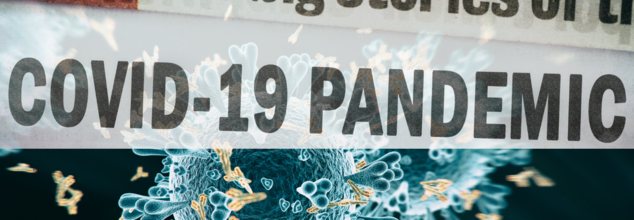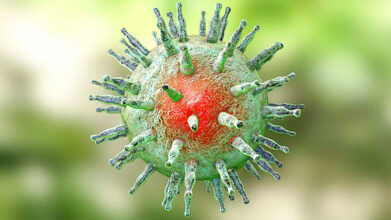- Health Conditions A-Z
- Health & Wellness
- Nutrition
- Fitness
- Health News
- Ayurveda
- Videos
- Medicine A-Z
- Parenting
Covid Cases Surge In Singapore: What Do We Know About The New Variant On The Loose?

Credits: Canva
Covid is again making headlines as Singapore experiences a significance surge in COVID-19 cases. The spike has been concerning as the number of cases rose from the week of April 27 to May 3 to 14,200 cases, as compared to 11,100 cases in the last week.
As per the Ministry of Health, the spike in cases is attributed to the new variant which may be on the loose - LF.7 and NB.1.8. These two are descendants of the JN.1 variant.
The cases have also spiked in Hong Kong. Thus Hong Kong's Centre for Health Protection (CHP) said that the rising COVID activity reached a 1-year high and have urged people to take precautions and receive an initial dose of COVID vaccine as soon as possible.
The Ministry of Health, Singapore, informed, "LF.7 and NB.1.8 are the main Covid-19 variants circulating in Signapore." They are the descendants of the JN.1 variant that is used in COVID-19 vaccines.
"At precent, LF.7 and NB.1.8 are the main COVID-19 variants circulating in Singapore, together accounting for more than two-thirds of locally sequenced cases. JN.1 is also the variant used in the formulation of the current COVID-19 vaccines," said Ministry in the statement.
What Are The Symptoms Of This New Variant?
The symptoms which are associated with this current Covid wave are a bit different from what we have seen before. While cough and sore throat are there, the symptoms also include nausea, vomiting, brain fog, and conjunctivitis.
The symptoms however are mild. The experts have for now asked people to monitor their health and seek medical attention in case it is required.
In Hong Kong, the situation seems serious as the experts have warned that "the virus activity is quite high". As of May 3, 31 deaths were reported among 81 severe Covid cases. 83% of the people infected were those above the age of 65.
In a press release, the Ministry of Health said, "Individuals at increases risk of severe COVID-19, such as those aged 60 years and above, medically vulnerable individuals or residents of aged care facilities, are recommended to keep updated with vaccinations, i.e. to receive an additional dose around one year after their last dose. Healthcare workers and persons living or working with medically vulnerable individuals are also encouraged to receive the vaccine. Other individuals aged six months and above who wish to receive the COVID-19 vaccine can continue to do so."
Sewage samples showed a rise in viral load, accompanied by an increase in respiratory samples testing positive for Covid-19. Meanwhile, Thailand’s Department of Disease Control reported two cluster outbreaks in 2025.
The public has also been advised to practice the standard precautions, including mask-wearing in crowded places, regular handwashing, and staying at home when unwell.
Should India Be Concerned?
As reported in Medical Buyer, Sabine Kapasi, advisor, public health and healthcare services, strategist, United Nations COVID-19 Task Force, said India's Covid situation is relatively stable, with a low number of active cases. "States like Kerala and Tamil Nadu are testing more due to their higher case loads," she noted.
As per the data from COVID-19 dashboard, more than 85% of new cases, which makes 46 out of 58 cases in India, have come from Tamil Nadu, Kerala, and Puducherry.
Novo Nordisk To Roll Out Obesity Pill Soon? Here’s All You Should Know

Credits: Canva
All eyes are on new obesity treatments, and a potential pill from Novo Nordisk could be among the first to reach patients. The Danish pharmaceutical company’s 25-milligram oral version of its obesity drug Wegovy may receive approval by year-end. While awaiting regulatory clearance, Novo Nordisk presented fresh data at the ObesityWeek conference in Atlanta last week, highlighting the pill’s safety and effectiveness.
“I believe this adds to the evidence doctors and patients can use to decide what may be most suitable for each individual,” said Dr. Jason Brett, Novo Nordisk’s principal U.S. medical head, discussing the new findings.
The pill’s debut is especially significant as Novo Nordisk recently lost a competitive bid with Pfizer over the obesity biotech Metsera. With Eli Lilly gaining more ground in the weight loss medication market, Novo Nordisk is aiming to strengthen its product pipeline.
Wegovy Oral Pill Will Have Cardiovascular Benefits
Data from the OASIS 4 clinical trial showed that the pill not only improved weight loss but also offered cardiovascular benefits and better blood sugar control, as per NBC News.
Among participants with prediabetes, 71.1% who took the pill achieved normal blood glucose after 64 weeks, compared with 33.3% on a placebo. Participants were more likely to lose at least 15% of their body weight, and those who did saw notable improvements in blood pressure, inflammation markers, and triglycerides.
Comparable Results to Wegovy
An indirect comparison of the OASIS 4 trial with earlier studies of injectable Wegovy found that the oral and injectable versions delivered similar results in weight loss, cardiometabolic improvements, and safety.
“That’s not too surprising; semaglutide is semaglutide,” Brett said as per NBC News, referring to the active ingredient in both Wegovy and the diabetes medication Ozempic. “We’re just delivering it differently.”
While some patients are fine with a weekly injection, Brett emphasized the importance of having alternative options. “It will expand access and help more patients benefit from weight loss treatment, especially those hesitant about injections,” he added.
Weight Loss Across Menopause Stages
The trial also examined weight loss in women at different stages of menopause. Pre-menopausal participants lost an average of 18.2% of their body weight over 64 weeks. Peri- and post-menopausal women lost 15% and 15.7%, respectively.
Brett noted that even small differences between groups, the overall weight loss was “robust and significant,” highlighting that menopause-related hormonal changes can make shedding weight more challenging.
Improvements in Physical Function
Participants who initially reported low physical function showed improvements after taking the pill. The study measured function using the Patient Global Impression of Status questionnaire.
A “meaningful change” in physical function occurred in 77.3% of pill users compared to 42.9% of those on placebo.
GLP-1 Pricing and Accessibility
During a recent visit to Washington, discussions also focused on GLP-1 drug prices, including Novo Nordisk and Eli Lilly medications. The Trump administration highlighted negotiations that brought Medicare and Medicaid prices in line with those in Europe.
However, it’s unclear if these lower prices will extend to commercial and employer plans, leaving many Americans with private insurance still facing high costs. Pharmacy benefit managers may need additional pressure or negotiations to match government pricing for 2026 contracts.
“The companies have committed to ensure, at worst, prices are at the most-favored nation level and to continue lowering prices based on volume,” said Chris Klomp, Medicare Director.
With the focus on affordable access, major insurers may already be feeling pressure to respond, especially after public scrutiny from former President Trump regarding insurance costs.
Epstein-Barr Virus May Be the Hidden Trigger Behind Lupus — Here’s What Scientists Found

Credits: Canva
One of the most common viruses in the world could be behind lupus, an autoimmune condition with a wide range of symptoms, according to a study released Wednesday. Lupus has long puzzled doctors: No single cause has been identified, and there is no standard treatment.
However, new research, published in Science Translational Medicine, suggests that Epstein-Barr virus, which infects 95% of people at some point in their lives, may trigger lupus by prompting the body to attack its own healthy cells.
Also Read: New Malaria Drug 2025: GanLum Outperforms Standard Treatment, Could Save Millions
Epstein-Barr Virus: What Is It?
Epstein-Barr virus (EBV) is a widespread herpesvirus that infects most people globally and is the main cause of infectious mononucleosis, also called mono. It spreads primarily through saliva, meaning kissing, sharing drinks, or close personal contact can pass the virus.
For most, EBV causes a short-lived illness with symptoms such as fatigue, fever, and sore throat. Once infected, the virus stays in the body for life, often without causing further problems, though it has been linked to certain cancers and autoimmune diseases, especially in people with weaker immune systems, according to the Centers for Disease Control and Prevention.
This adds to growing evidence connecting EBV to long-term health issues, including autoimmune conditions. Researchers say the findings strengthen the case for developing a vaccine targeting the virus.
In people with lupus, the immune system attacks the body, causing extreme fatigue, joint pain, and skin rashes. In rare cases, the disease can lead to serious complications like kidney damage or make the body less able to fight infections.
Also Read: Botulism Infant Formula Recall 2025: ByHeart Expands Nationwide Recall After 15 Babies Hospitalized
Epstein-Barr Virus and the Lupus Link
Scientists have long suspected a connection between EBV and lupus, but the exact link remained unclear. Dr. William Robinson, co-author of the study and chief of immunology and rheumatology at Stanford University, said the new findings solve a key piece of the puzzle.
“From our perspective, it’s the missing mechanistic link,” Robinson said. “We believe it could apply to all lupus cases,” he added. Hundreds of thousands in the U.S. live with the disease.
However, Hoang Nguyen, assistant vice president of research at the Lupus Research Alliance, cautioned that it’s too early to say whether this mechanism explains every case, as per NBC News.
“While the evidence is promising, more research is needed to confirm if EBV is the trigger for all lupus,” Nguyen said. The alliance, a private funder of lupus research, provided grant support for the study.
Epstein-Barr Virus Transmission
Not everyone infected with EBV shows symptoms, especially children, although the virus is the most common cause of mononucleosis. It spreads mainly through saliva, by kissing or sharing drinks, food, utensils, or toothbrushes. Once in the body, EBV usually stays dormant, though sometimes it reactivates.
This isn’t the first time EBV has been tied to autoimmune disorders. Earlier research has linked it to multiple sclerosis, though it is likely one factor among many in the disease’s development.
Robinson noted that the pathway his team identified might also contribute to other autoimmune diseases, including rheumatoid arthritis and Crohn’s disease, though more work is needed to explore that.
Most people infected with EBV never develop lupus, MS, or other autoimmune conditions. Robinson said certain strains of EBV may be more likely to trigger autoimmune reactions.
Epstein-Barr Virus: What Diseases Are Associated With Epstein Barr Virus?
To explore the link with lupus, Robinson and colleagues focused on B cells, white blood cells that fight infections. Even in healthy people, EBV lies dormant in a small portion of B cells. But in lupus patients, these infected B cells are far more common — up to 25 times higher than in healthy individuals, according to the study.
The research also highlights antinuclear antibodies, proteins that attach to cell nuclei and are a hallmark of lupus. Epstein-Barr infects B cells and reprograms them to produce these antibodies, which then attack healthy tissue.
Robinson said the findings align with other theories of lupus, including genetic and hormonal factors that may make someone more vulnerable to the disease. A 2024 *Nature* study also found lupus patients have too many of a certain T cell type associated with cell damage, and too few T cells that aid repair. The pathway Robinson describes could trigger these immune responses.
Epstein-Barr Virus: Is Treatment Possible?
The study points to new possibilities for lupus therapy. Currently, treatments mainly reduce inflammation, such as corticosteroids. Robinson said future drugs could target B cells infected with EBV specifically.
Meanwhile, vaccines in clinical trials could prevent EBV infection entirely. “Vaccination to stop EBV infection would be the ultimate way to prevent these autoimmune diseases,” Robinson said, as per NBC News.
White House Says Trump’s MRI Was Part of Routine Examination, Declines To Disclose Health Findings

Credits: AP Newsroom
The White House on Wednesday declined to share specific information about the medical scans President Donald Trump underwent during a physical examination last month, though it said overall results showed he remains in excellent health. Trump, 79, had earlier confirmed that he received a magnetic resonance imaging (MRI) scan at Walter Reed Medical Center on October 10. However, neither he nor the White House clarified which part of his body was scanned.
White House Refuses To Disclose Donald Trump’s Health Results
White House Press Secretary Karoline Leavitt was asked again on Wednesday about her earlier statement that she would follow up with the President regarding his MRI in October. Leavitt thanked reporters for the question but did not provide any further details. She confirmed that Trump “received advanced imaging” at Walter Reed National Military Medical Center as part of his “routine physical examination” but did not mention which body part was examined.
MRIs are typically conducted to capture detailed images of areas such as the brain, spine, joints, heart, or blood vessels. Trump’s scan came during his second physical exam of the year. When pressed for additional details about the test, Leavitt declined to elaborate.
“The full results were reviewed by attending radiologists and consultants, and all agreed that President Trump remains in exceptional physical health,” Leavitt said, according to Reuters.
Concerns About Donald Trump’s Health Grow
Between August 26 and September 2, 2025, speculation about Trump’s health began circulating online after photos showed bruising on his hand and he avoided public appearances for several days. Some users claimed the White House was concealing a medical issue, prompting Trump to respond directly to the rumors on September 2.
The Trump administration had previously shared results from a physical conducted in April 2024, though questions were raised about whether it included all relevant findings. Trump has often highlighted his performance on a cognitive test, but experts have pointed out that the test alone cannot confirm or rule out cognitive impairment.
Adding to the speculation was a visible bruise on the back of Trump’s right hand, which has occasionally appeared covered with makeup. In February, the White House said the bruise came from Trump “constantly working and shaking hands all day.” His doctor also stated in July that Trump takes aspirin daily as part of a “cardiovascular prevention regimen,” which can sometimes lead to bruising.
What Health Condition Has Trump Been Diagnosed With?
Although public discussion about Trump’s health continues to surface, the White House has consistently maintained that he remains in strong physical condition. Earlier this year, officials confirmed that he has chronic venous insufficiency (CVI)—a vascular condition that makes it harder for veins in the legs to send blood back to the heart. It can cause mild swelling or discomfort.
On October 10, Trump visited Walter Reed Medical Center again for what his spokesperson described as a “routine annual check-up,” though it marked his second visit in six months. The White House physician, Dr. Sean Barbabella, declined to specify which scans or preventive evaluations were done but said the test results were “exceptional” and that Trump’s heart health was comparable to that of someone about 14 years younger.
Later, on October 27, Trump said he had undergone an MRI during a prior visit to Walter Reed and described the findings as “some of the best reports for the age.” He added that doctors were “very impressed”, though the absence of specific details has fueled ongoing curiosity about his condition.
Trump has also mentioned taking the Montreal Cognitive Assessment (MoCA), a tool designed to detect early cognitive decline, but often refers to it as a “very tough IQ test.” It remains unclear whether he took another MoCA during his October appointment or was referencing earlier tests from April 2025 or January 2018.
© 2024 Bennett, Coleman & Company Limited

